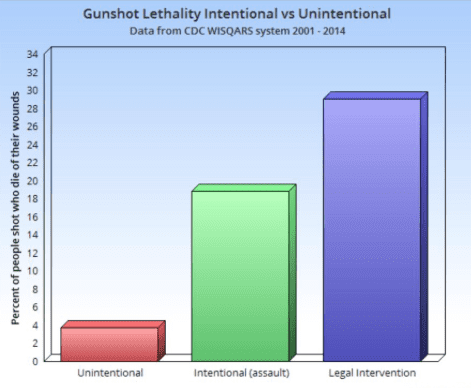
When attempting to determine the statistical lethality of gunshot wounds, an important variable is often overlooked. That is the intention of the shooter. It is not an easy variable to measure, but it is an overwhelming part of the dynamics of shooting situations.
The Centers for Disease Control and Prevention has been collecting data on firearms injuries and fatalities since 2001. The individual years data have warnings that the numbers may be too small to be reliable, but there are significant advantages to the data set when looking at the aggregate numbers for the fourteen year period.
All the data is collected under the same institutional frame work, so we can hope for internal consistency. While the network of hospitals that report to the CDC only cover a part of the country, they generate significant numbers to work with.
There are three categories in the CDC WISQARS data that can shed light on the importance of intention on the lethality of gunshot wounds. From cdc.gov:
Unintentional: This category refers to fatal and nonfatal injuries not deliberately inflicted, including any such injury described as an “accident,” regardless of whether inflicted by oneself or by another person. Injuries resulting in hospitalization subsequent to ED treatment or resulting in ED treatment only, and for which intent was not determined, are also included in this category as most such injuries were likely unintentional. (It should be noted that approximately 20% of nonfatal firearm-related injuries assigned to the “unintentional” category were cases with undetermined intent, based on a retrospective review of narratives describing the injury incidents. Cost estimates for nonfatal firearm-related injuries designated as “unintentional” should be interpreted with this in mind.)
Homicide/Assault: This category refers to fatal and nonfatal injuries due to acts of violence where physical force by one or more persons is used with the intent of causing harm, injury, or death to another person. Such injuries resulting in hospitalization subsequent to ED treatment or resulting in ED treatment only are reportable under the categories assault-other and assault-sexual, which include confirmed and suspected cases based on patient medical records.
Legal Intervention: This category refers to fatal and nonfatal injuries caused by police or other law enforcement agents in the course of official duties. For injury-related deaths this category includes state-sanctioned executions.
The least intentional category in the CDC database is labelled as “unintentional”. In this category, the CDC notes that 20% of the incidents are undetermined in terms of intent. This category had one fifth the percentage of fatalities of assault/homicide cases, and a little more than one eighth the percentage of fatalities of legal interventions.
Unintentional shootings reported by the CDC from 2001 to 2014, 231,350. Total fatalities were 8,969. Lethality was 3.73%
The assault category is the next most intentional group. The CDC does not differentiate between justifiable shootings and non-justifiable. It is unlikely that a person shoots at someone with no intention of hurting them; but some shootings are to warn, to scare off, to facilitate escape, to create/enforce territorial boundaries for street gangs, or intentional woundings.
Assault/Homicide shootings reported by the CDC from 2001 to 2014, 872,436. Total fatalities were 164,089. Lethality was 18.8%.
It is not hard to understand the mechanism for increased lethality with increased intention to harm or kill. A shooter has many choices. If the intention is to intimidate or enforce territorial boundaries, distance and accuracy are not as important. If the intention is self defense, a person who is wounded and runs away or retreats serves as well as one who is killed. If the intention is to kill, then the choice may be to shoot more, to get closer, to deliver a coup de grace to a downed opponent or victim.
Only one person appears to have been legally executed by gunfire in the United States from 2001 to 2014. That was Ronnie Lee Gardner, in 2010. Legal executions are not statistically significant in shooting statistics.
In the legal intervention category, police are taught to aim for the center of mass in their training. They are taught not to shoot at people who are not a deadly threat, so a high level of intentionality can be assigned to their actions. They are taught not to aim for extremities or to shoot to “disable.”
Center mass shots are more likely to be fatal than any other part of the body except for shots to the head. They are more likely to stop an attack than hits in the extremities. There is considerable speculation that a percentage of police shootings are “suicide by cop”, where the person shot wants to die, and uses the police as a method of doing so.
People shot in legal intervention shootings reported by the CDC from 2001 to 2014, were 17,894. Total fatalities were 5,181. Lethality was 29.0%
It may seem obvious that the most important part of shooting dynamics is the intention of the shooter. These numbers from the CDC support that conclusion.
©2016 by Dean Weingarten: Permission to share is granted when this notice is included.
Link to Gun Watch




They do not seem to separate out rifles from
Pistols
Any rifle, even one shooting pistol caliber bullets , will have greater velocity and be more lethal than a handgun
Rifles are a tiny component of gunshot wounds in the U.S.
Only about 2-3% of fatalities are from rifles.
^^^This. And from that 2-3% of all firearm-related fatalities that involved a rifle, we can estimate about 0.4% involved an “military-style” semi-automatic rifle.
So to recap, out of 11,000 homicides in 2014 in the US, about 0.4% were accomplished with an AR or AK – roughly 44 people.
By comparison:
There were 29,898 people killed it traffic accidents in that same year, or 679 Times more.
There were 3.563 people drowned in swimming pools in that same year, or 80 times more.
“…police are taught to aim for the center of mass in their training….Center mass shots are more likely to be fatal than any other part of the body except for shots to the head.”
And when there are 12 officers doing full mag dumps on the suspect, death usually follows (unless you are in NYC, in which case many bystanders are injured, property damage occurs, and the bad guy lays curled on the ground, un-hit, thanking his stars for 12lb triggers!
Yup! 2+ thumbs up! Always plenty of dark comedy from NYPD! Keystone cop stuff !
Any rifle, even one that fires bullets of pistol caliber, will have greater velocity and be more lethal than a handgun. This is true regardless of the caliber of the bullets it fires.
Comments are closed.